SK Telecom Bundle
How is South Korea Telecom Revolutionizing the Tech World?
SK Telecom (SKT), a powerhouse in South Korea's telecommunications, is undergoing a remarkable transformation. This strategic pivot positions SKT as a global AI leader, significantly impacting its financial trajectory. With impressive 2024 results, including a notable surge in AI-related revenue, SKT's evolution offers a compelling case study in corporate innovation.
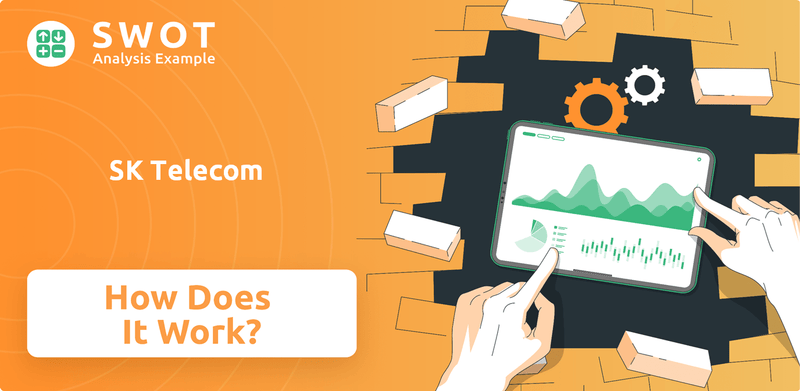
As a leading Korean telecom and mobile network operator, SKT provides a diverse range of services, from mobile communication to broadband internet. Its impressive SK Telecom SWOT Analysis reveals the strengths and opportunities driving its success. This exploration delves into SK Telecom's business model, revenue streams, and strategic moves, providing crucial insights for investors and industry watchers keen on understanding how SKT makes money and its future plans within the dynamic technology landscape. Discover the secrets behind SK Telecom's innovation and its impact on the global stage.
What Are the Key Operations Driving SK Telecom’s Success?
The core operations of SK Telecom, often referred to as SKT, revolve around providing comprehensive telecommunications services. This includes mobile communication, fixed-line telephone, broadband internet, and media services. The company is a major player in the Korean telecom market, serving a large customer base in South Korea.
SKT's operational processes are extensive, involving significant network infrastructure management and continuous technology development. They focus on advancements in 5G, AI, and IoT. Customer service platforms are also a crucial part of their operations, ensuring customer satisfaction and retention. SKT's business model is evolving, with a strong emphasis on integrating AI to create value.
The value proposition of SK Telecom is increasingly driven by its 'AI Pyramid Strategy.' This strategy focuses on three key areas: AI infrastructure, AIX (AI transformation), and AI services. This approach aims to enhance connectivity, offer personalized AI services, and provide efficient B2B solutions, setting SKT apart from traditional telecom providers. For more information about their target market, you can read about the Target Market of SK Telecom.
SK Telecom is building an 'AI Infra Super Highway' across Korea, which includes AI Data Centers (AI DC), GPU-as-a-Service (GPUaaS), and Edge AI. This involves establishing hyperscale AI data centers with substantial electricity capacities. The Gasan AI data center, launched in December 2024, offers GPUaaS services with NVIDIA H100 Tensor Core GPUs, with plans to introduce H200 Tensor Core GPUs in Q1 2025.
SKT focuses on AI-based business innovations and B2B solutions, including AI Contact Center (AICC) and Vision AI. This area aims to enhance group-wide synergies within the SK Group. Collaborations with global tech giants are also a key part of this strategy, driving innovation and efficiency.
The company offers its domestic personal AI assistant 'A.' (A-Dot), which had over 9 million cumulative users in Q1 2025. Additionally, SKT launched the global AI agent 'Aster' (A) in open beta in the U.S. at the end of March 2025. These AI capabilities are designed to improve customer experience and provide advanced services.
SKT has formed strategic partnerships with companies like Lambda, Penguin Solutions, Anthropic, Perplexity, MIT, and IonQ. These partnerships are crucial for bolstering its technological capabilities and market differentiation, ensuring it remains at the forefront of innovation in the telecommunications sector.
SK Telecom differentiates itself through enhanced connectivity, personalized AI services, and efficient B2B solutions. These advancements provide significant benefits to its customers, setting it apart from traditional telecom providers. The company continues to invest in its 5G network and AI technologies to maintain its competitive edge in the Korean telecom market.
- Enhanced Connectivity: Improving network speeds and reliability.
- Personalized AI Services: Offering tailored experiences through AI assistants.
- Efficient B2B Solutions: Providing AI-driven solutions for businesses.
- Technological Innovation: Continuous investment in 5G, AI, and IoT.
SK Telecom SWOT Analysis
- Complete SWOT Breakdown
- Fully Customizable
- Editable in Excel & Word
- Professional Formatting
- Investor-Ready Format
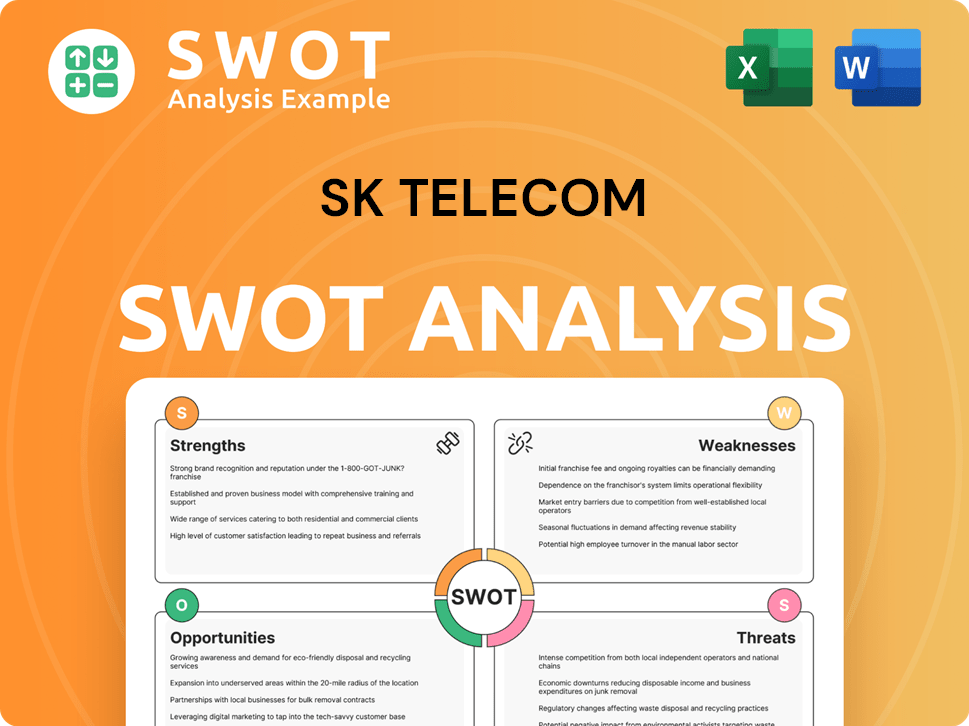
How Does SK Telecom Make Money?
SK Telecom (SKT), a leading telecommunications company in South Korea, strategically diversifies its revenue streams across traditional telecom services and burgeoning AI businesses. The company's financial performance in 2024 reflects this dual focus, with substantial revenues generated from both mobile communications and emerging AI-driven ventures.
The financial results for 2024 demonstrate SKT's strong position in the Korean telecom market. Consolidated revenues reached 17.94 trillion Korean won ($12.34 billion), while the non-consolidated revenue, excluding subsidiaries, was 12.77 trillion won ($8.78 billion). This financial health underscores SKT's ability to maintain a robust presence in its core telecommunications sector while investing in future growth areas like AI.
The company's monetization strategies are evolving to leverage its AI investments. SK Telecom's 'AI Pyramid 2.0' strategy, unveiled in 2025, outlines three main monetization methods for AI: AI Data Centers (AI DC), AI B2B, and AI B2C. This includes offering various AI DC business models such as subscription-based AI cloud GPUaaS, small modular AI DC, dedicated AI DC for individual clients, and hyperscale AI DC. The company is also exploring e-commerce integration and licensing models for its AI software services. These strategies reflect a shift towards a future where telecom services are intertwined with AI and cloud technologies, creating new revenue streams and enhancing existing ones through innovative offerings and bundled services.
SK Telecom's revenue streams are primarily composed of mobile communication services, fixed-line and media services, and AI businesses. Mobile services are a significant contributor, with 31.8 million mobile customers, including 16.9 million 5G subscribers. Fixed-line services, provided by SK Broadband, and media services also contribute substantially. The AI sector is a key growth area, with AI-related revenue growing by 19% year-on-year in 2024.
- Mobile Communication Services: In late 2024, SKT had 31.8 million mobile customers, including 16.9 million 5G subscribers. Mobile service revenue for Q4 2024 was flat at 2.66 trillion won.
- Fixed-line, Broadband Internet, and Media Services: SK Broadband contributed 4.4111 trillion won in revenue in 2024, a 3.1% year-on-year increase.
- AI Businesses: AI-related revenue grew by 19% year-on-year in 2024.
- AI Data Centers (AIDC): In Q1 2025, AIDC business recorded revenue of 102.0 billion won, an 11.1% year-on-year increase.
- AIX (AI Transformation) Business: This segment generated 193 billion won ($132.8 million) in 2024, up 30% year-on-year. In Q1 2025, AIX revenue grew 27.2% year-on-year to 45.2 billion won.
- GPU-as-a-Service (GPUaaS): Launched in December 2024, this subscription-based service is expected to drive rapid revenue growth.
- Personal AI Agent (PAA): SKT plans to introduce a subscription-based paid service for its domestic 'A.' personal AI agent within 2025.
SK Telecom PESTLE Analysis
- Covers All 6 PESTLE Categories
- No Research Needed – Save Hours of Work
- Built by Experts, Trusted by Consultants
- Instant Download, Ready to Use
- 100% Editable, Fully Customizable
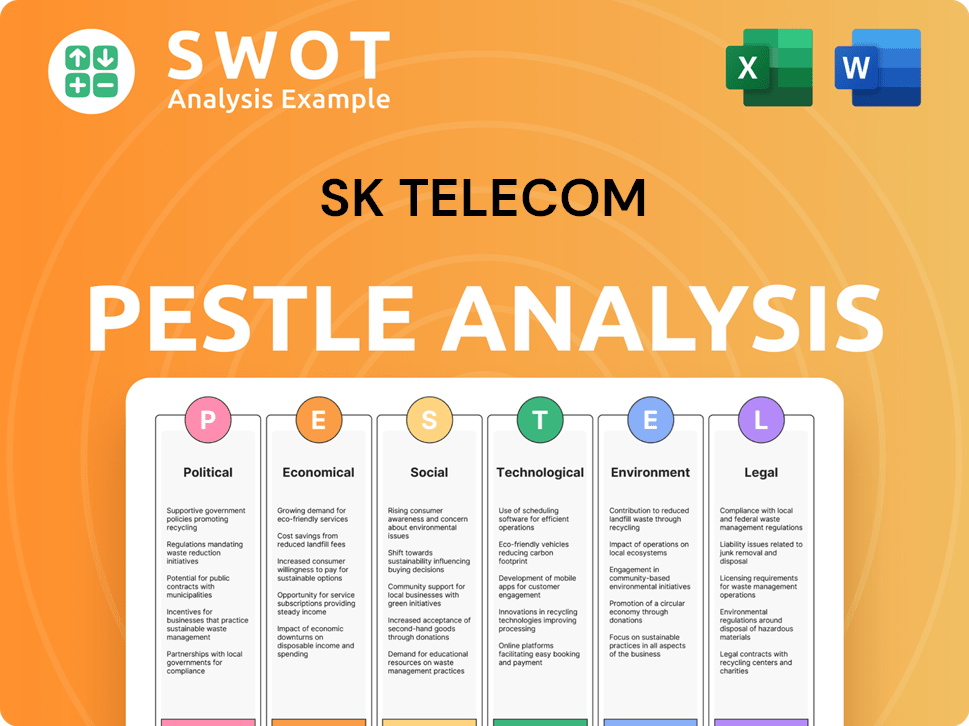
Which Strategic Decisions Have Shaped SK Telecom’s Business Model?
SK Telecom (SKT) has undergone a significant transformation, evolving from a telecommunications company into an AI-focused entity. This strategic shift is marked by key milestones, strategic moves, and a focus on maintaining a competitive edge in the rapidly changing tech landscape. The company's aggressive pivot towards artificial intelligence reflects its ambition to lead in both the telecom and AI sectors, as highlighted by its rebranding and restructuring in late 2024 for 2025.
A pivotal move was the reorganization of SKT into seven business divisions, designed to drive tangible results in both telecom and AI. This restructuring underscores the company's commitment to innovation and its ability to adapt to emerging technologies. The company's strategic initiatives and partnerships are aimed at solidifying its position in the market and expanding its global reach.
The company's evolution is a testament to its forward-thinking approach, positioning it to capitalize on future opportunities in the tech industry. This transformation is supported by a series of strategic moves and milestones. Specifically, SK Telecom is focusing on monetizing its AI business, aiming for significant revenue growth from AI in 2025.
SK Telecom's journey is marked by significant milestones that highlight its strategic direction. These milestones demonstrate the company's commitment to innovation and expansion in the telecom and AI sectors. The company's proactive approach to technological advancements is evident in its strategic initiatives.
Strategic moves have been crucial in SK Telecom's transformation. These moves reflect SKT's commitment to innovation, including its rebranding as an AI company and the restructuring of its business divisions. The company's strategic partnerships and investments in AI infrastructure are key components of its growth strategy.
SK Telecom maintains a competitive edge through its strong brand, leading market share, and technological leadership. Its focus on AI and strategic partnerships further enhance its position in the market. The company's ability to adapt and innovate is key to its continued success.
SK Telecom aims for significant revenue growth from AI in 2025. The company is also focused on reducing organizational layers for faster decision-making. The financial performance of SKT is crucial for its future growth and sustainability in the competitive telecom market.
SK Telecom's strategic initiatives and partnerships are central to its growth strategy. These collaborations bolster its AI capabilities and expand its global reach. SKT's investments in AI infrastructure and services further distinguish it in the market.
- AI Pyramid Strategy (September 2024): Focused on AI infrastructure, AIX, and AI services.
- AI Infra Super Highway Plan (November 2024): Building a national network of regional AI data centers.
- Gasan AI Data Center Launch (December 2024): Opened in cooperation with Lambda, introducing 'SKT GPUaaS'.
- Launch of 'A.' and 'Aster': Domestic and global AI assistants with millions of users.
- Strategic Partnerships: Collaborations with global leaders like Lambda, Penguin Solutions, Anthropic, Perplexity, MIT, and IonQ. Its partnership with IonQ in March 2025 aims to integrate quantum computing with AI technologies.
SK Telecom Business Model Canvas
- Complete 9-Block Business Model Canvas
- Effortlessly Communicate Your Business Strategy
- Investor-Ready BMC Format
- 100% Editable and Customizable
- Clear and Structured Layout
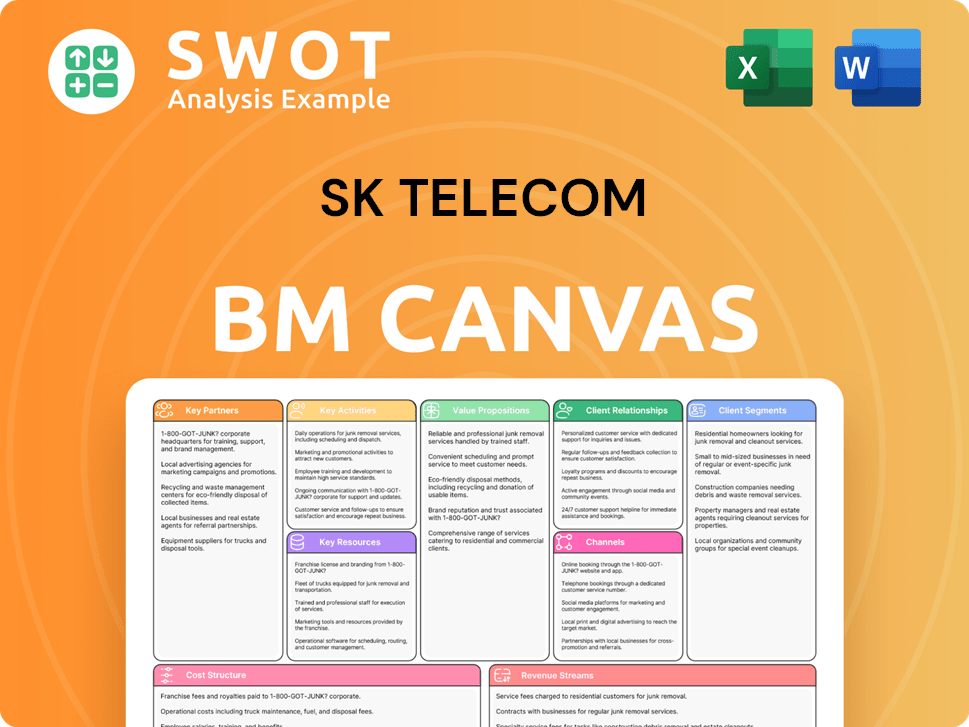
How Is SK Telecom Positioning Itself for Continued Success?
As South Korea's largest wireless telecommunications operator, SK Telecom (SKT) commands a significant market presence, holding nearly 45% of the wireless market share. The company's strong position is further bolstered by its leadership in postpaid contract customers, contributing to the highest average revenue per user (ARPU) among its domestic competitors. Through its subsidiary, SK Broadband, SKT also strengthens its foothold in the fixed-line broadband and pay-TV sectors. SKT's expansion includes strategic partnerships and the upcoming launch of its global AI agent, Aster, in North America.
However, SK Telecom faces several challenges. Intense competition in the telecommunications sector has historically impacted wireless operating profit. Regulatory changes and the need for continuous innovation, especially in rapidly evolving technologies like AI and 5G, also pose challenges. Cybersecurity risks, as highlighted by past incidents, necessitate robust security measures. Moreover, SKT anticipates a slight dip in total revenues for 2025, projecting consolidated operating revenue of 17.8 trillion won, down from 2024, though operating profit is expected to increase.
SK Telecom is a leading Korean telecom company with a substantial market share in South Korea's wireless market. Its strong customer base and high ARPU indicate a robust and competitive business model. The company's fixed-line and pay-TV services, through SK Broadband, further establish its comprehensive service offerings.
The Mobile network operator faces risks from intense competition and the need for constant technological innovation. Regulatory changes and cybersecurity threats also pose significant challenges. The company anticipates a slight revenue decrease in 2025, despite an expected rise in operating profit.
SKT is committed to its 'AI Pyramid 2.0' strategy, aiming to become a global AI company. This involves expanding AI infrastructure, monetizing AI services, and global expansion. The company is focused on operational improvements and cost optimization to maintain profitability.
SK Telecom projects consolidated operating revenue of 17.8 trillion won for 2025, slightly down from 2024. Despite the revenue dip, the company anticipates an increase in operating profit. The company's financial performance is influenced by factors such as ARPU, data consumption, and strategic investments.
SK Telecom is actively pursuing its 'AI Pyramid 2.0' strategy, investing in AI infrastructure, and expanding its AI business globally. The company aims to grow its B2B AI revenue by 30% in 2025 and achieve double-digit growth for AIDC. Partnerships, like the one with IonQ in March 2025, are key to integrating quantum computing with AI.
- AI Infrastructure Superhighway: Building national AI data centers, enhancing edge AI, and expanding GPUaaS offerings.
- AI Business Monetization: Targeting 30% growth in B2B AI revenue in 2025 and double-digit growth for AIDC.
- Global AI Expansion: Launching Aster in the U.S. in the first half of 2025 and exploring global partnerships.
- Quantum-AI Integration: Partnering with IonQ to enhance AI performance and reduce power consumption.
SK Telecom Porter's Five Forces Analysis
- Covers All 5 Competitive Forces in Detail
- Structured for Consultants, Students, and Founders
- 100% Editable in Microsoft Word & Excel
- Instant Digital Download – Use Immediately
- Compatible with Mac & PC – Fully Unlocked
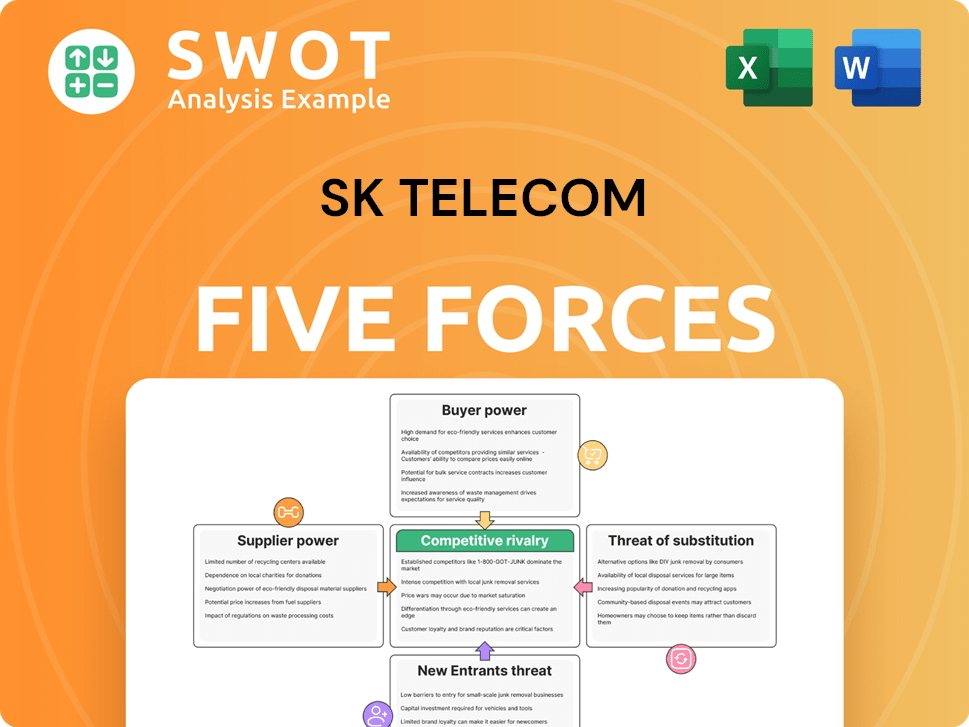
Related Blogs
- What are Mission Vision & Core Values of SK Telecom Company?
- What is Competitive Landscape of SK Telecom Company?
- What is Growth Strategy and Future Prospects of SK Telecom Company?
- What is Sales and Marketing Strategy of SK Telecom Company?
- What is Brief History of SK Telecom Company?
- Who Owns SK Telecom Company?
- What is Customer Demographics and Target Market of SK Telecom Company?
Disclaimer
All information, articles, and product details provided on this website are for general informational and educational purposes only. We do not claim any ownership over, nor do we intend to infringe upon, any trademarks, copyrights, logos, brand names, or other intellectual property mentioned or depicted on this site. Such intellectual property remains the property of its respective owners, and any references here are made solely for identification or informational purposes, without implying any affiliation, endorsement, or partnership.
We make no representations or warranties, express or implied, regarding the accuracy, completeness, or suitability of any content or products presented. Nothing on this website should be construed as legal, tax, investment, financial, medical, or other professional advice. In addition, no part of this site—including articles or product references—constitutes a solicitation, recommendation, endorsement, advertisement, or offer to buy or sell any securities, franchises, or other financial instruments, particularly in jurisdictions where such activity would be unlawful.
All content is of a general nature and may not address the specific circumstances of any individual or entity. It is not a substitute for professional advice or services. Any actions you take based on the information provided here are strictly at your own risk. You accept full responsibility for any decisions or outcomes arising from your use of this website and agree to release us from any liability in connection with your use of, or reliance upon, the content or products found herein.